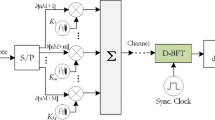Abstract
Impulse radio is a low-complexity ultra-wideband system which is suitable for highly dispersive multipath channel. In this paper, we propose a random correlation-based receiver for impulse radio communications. The proposed receiver correlates the received pilot symbols with the randomly generated base functions according to channel statistics and forms the detection template by combining several base functions which have larger correlation coefficients with the pilot symbols. The proposed receiver demodulates the received signal by employing a symbol rate sampling. Computer simulation results have shown that the proposed receiver outperforms the conventional correlator-based receiver, compressive sensing correlator-based receiver, weighted energy detector and autocorrelation receiver.



Similar content being viewed by others
References
Win, M. Z., & Scholtz, R. A. (2000). Ultra-wide bandwidth time-hopping spread-spectrum impulse radio for wireless multiple-access communications. IEEE Transactions on Communications, 48(4), 679–691.
Cassioli, D., Win, M. Z., Vatalaro, F., & Molisch, A. F. (2002). Performance of low-complexity rake reception in a realistic UWB channel. In Proceedings ICC 2002 (pp. 763–767).
Xu, Z., & Sadler, B. M. (2006). Multiuser transmitted reference ultra-wideband communication systems. IEEE Journal on Selected Areas in Communications, 24(4), 766–772.
Tang, J., Xu, Z., & Sadler, B. M. (2007). Performance analysis of \(b\)-bit digital receivers for TR-UWB systems with inter-pulse interference. IEEE Transactions on Wireless Communications, 6(2), 494–505.
Farhang, M., & Salehi, J. A. (2010). Optimum receiver design for transmitted-reference signaling. IEEE Transactions on Communications, 58(5), 1589–1598.
D’Amico, A. A. (2011). IR-UWB transmitted-reference systems with partial channel knowledge: A receiver design based on the statistical invariance principle. IEEE Transactions on Signal Processing, 59(4), 1435–1448.
Bagga, S., Zhang, L., Serdijn, W. A., Long, J. R., & Busking, E. B. (2005). A quantized analog delay for an IR-UWB quadrature downconversion autocorrelation receiver. In Proceedings ICU 2005 (pp. 328–332).
Tian, Z., & Sadler, B. M. (2005). Weighted energy detection of ultra-wideband signals. In Proceedings IEEE 6th workshop on signal processing advances in wireless communications (pp. 1068–1072).
Wu, J., Xiang, H., & Tian, Z. (2006). Weighted noncoherent receivers for UWB PPM signals. IEEE Communications Letters, 10(9), 655–657.
Zhang, Q., Nallanathan, A., & Garg, H. K. (2009). Monobit digital eigen-based receiver for transmitted-reference UWB communications. IEEE Transactions on Wireless Communications, 8(5), 2312–2316.
Paredes, J., Arce, G. R., & Wang, Z. (2007). Ultra-wideband compressed sensing: Channel estimation. IEEE Journal on Selected Topics in Signal Processing, 1(3), 383–395.
Wu, L., Wu, X., & Tian, Z. (2006). Asymptotically optimal UWB receivers with noisy templates: Design and comparison with Rake. IEEE Journal on Selected Areas in Communications, 24(4), 808–814.
Yang, L., & Giannakis, G. B. (2004). Optimal pilot waveform assisted modulation for ultrawideband communications. IEEE Transactions on Wireless Communications, 3(4), 1236–1248.
Molisch, A. F. et al. (2004). IEEE 802.15.4a channel model-final report. IEEE http://www.ieee802.org/15/pub/TG4a.html
Donoho, D. (2006). Compressed sensing. IEEE Transactions on Information Theory, 52(4), 1289–1306.
Acknowledgments
This work was supported by the National Natural Science Foundation of China under Grant 61173148 and Grant 61202498 and by the Scientific and Technological Project of Guangzhou City under Grant 12C42051578.
Author information
Authors and Affiliations
Corresponding author
Rights and permissions
About this article
Cite this article
Zhang, Q., Qin, J. Random Correlation-Based Receiver for Impulse Radio Communications in UWB Channels. Wireless Pers Commun 79, 21–30 (2014). https://doi.org/10.1007/s11277-014-1838-4
Published:
Issue Date:
DOI: https://doi.org/10.1007/s11277-014-1838-4




